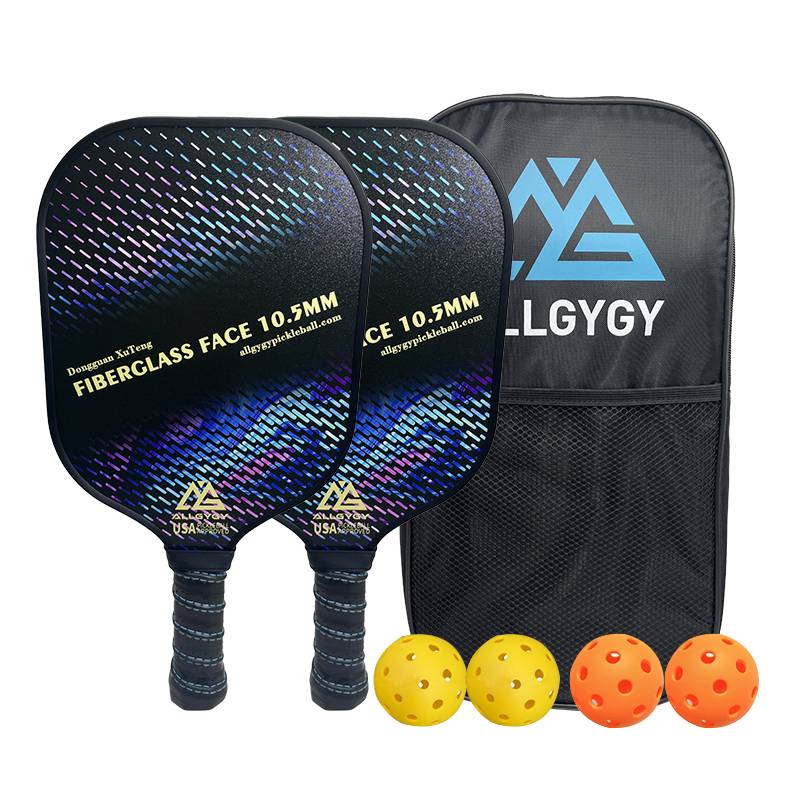What Makes a Great Pickleball Paddle and How Do You Choose the Right One?
2025-01-09
Pickleball has quickly gained popularity as one of the most exciting and accessible sports, attracting players of all ages and skill levels. Whether you’re playing for fun or aiming to compete at a higher level, one of the most important pieces of equipment you’ll need is a high-quality pickleball paddle. But with so many options on the market, how do you choose the right paddle that best suits your needs? What exactly makes a great pickleball paddle? In this blog, we’ll explore the key factors to consider when selecting a paddle and what sets the best ones apart from the rest.
What Is a Pickleball Paddle?
Before we dive into what makes a great pickleball paddle, let’s quickly define what it is. A pickleball paddle is the equipment used to hit the ball in pickleball, a sport that combines elements of tennis, badminton, and table tennis. The paddle is smaller than a tennis racket, usually made of composite materials, and has a solid face with no strings. Paddles come in a variety of shapes, sizes, and materials, each designed to cater to different playing styles and preferences.
What Factors Make a Great Pickleball Paddle?
1. Material of the Paddle Face
The face of the paddle is arguably the most important part when it comes to power and control. Paddles are typically made from a range of materials, each offering its own benefits. The most common materials include:
- Wood: Wood paddles are often the least expensive and suitable for beginners or recreational players. They are heavier, which can make them harder to control and less powerful, but they offer durability and affordability.
- Composite: Composite paddles are made from materials like fiberglass, carbon fiber, and polymer. They tend to offer a good balance of power and control, and their larger sweet spot makes them easier to play with. These paddles are popular among intermediate to advanced players.
- Graphite: Graphite paddles are known for their lightweight and responsive nature, offering excellent control and precision. They tend to be slightly more expensive but are preferred by competitive players who need both power and finesse.
2. Core Material
The core of the paddle plays a significant role in shock absorption, control, and power. The most common core materials are:
- Polymer: Polymer cores are typically found in mid-range paddles. They provide excellent durability and a soft feel, ideal for players who want a good balance between control and power. Polymer cores also offer superior sound dampening, making them a popular choice for recreational players.
- Nomex: Nomex is a type of honeycomb core material known for its high durability and firm feel, offering more power for players who want more aggressive shots. However, they can be a bit harder to control for beginners.
- Aluminum: Aluminum cores offer a good balance of strength and weight. They tend to provide a softer feel than Nomex but still offer plenty of power. Aluminum cores are often chosen by intermediate players who want a balance of power and control.
3. Weight of the Paddle
The weight of the paddle directly impacts how it handles and feels during play. Paddles typically come in three categories based on weight:
- Lightweight (6.5-7.3 oz): Lighter paddles are easier to maneuver and provide quicker reaction times, making them ideal for players who focus on control and quick volleys. Lightweight paddles also reduce the risk of fatigue, especially during longer games.
- Midweight (7.4-8.4 oz): Midweight paddles strike a balance between power and control. They are the most popular choice for recreational players and those who want a paddle that is easy to handle but still provides enough power for powerful smashes.
- Heavyweight (8.5-9 oz): Heavier paddles provide more power in your shots, making them ideal for aggressive players who want to hit hard, fast serves or groundstrokes. However, they can be more difficult to control and require more strength to maneuver.
4. Grip Size
Grip size is another essential factor in choosing the right pickleball paddle. A paddle with the wrong grip size can cause discomfort or even lead to injuries like tennis elbow. Grip sizes range from small to large, and the right size will depend on your hand size and comfort level.
- Small grip: Suitable for players with smaller hands, offering better maneuverability and faster wrist action.
- Medium grip: Ideal for players with average hand sizes, offering a balance between control and comfort.
- Large grip: For players with larger hands, providing more stability and control, especially for players who like to use two hands for certain shots.
If you’re unsure of your grip size, you can measure the circumference of your hand just below your knuckles and match it to a grip size chart.
5. Shape and Design
Pickleball paddles come in a variety of shapes, and the shape can impact your playing style. The most common paddle shapes are:
- Wide-body paddles: These paddles have a larger hitting surface, making them more forgiving for beginners. The extra surface area offers a larger sweet spot for hitting, helping players who might miss the ball often.
- Standard paddles: These paddles offer a more traditional shape and are popular among experienced players. They provide more maneuverability but require greater precision and skill to control effectively.
- Elongated paddles: These paddles offer a longer reach and more power, making them ideal for power hitters who want to hit long shots and serve with strength. However, they can be less forgiving and require excellent ball control.
6. Durability and Construction
A great pickleball paddle should be durable enough to withstand hours of play. Paddles made with high-quality composite materials, such as carbon fiber or fiberglass, tend to last longer and resist damage. You should also consider the construction quality, especially if you’re looking for something that can handle outdoor conditions, where wind, rain, or rough surfaces might be a concern.
How to Choose the Right Pickleball Paddle for You?
Choosing the right pickleball paddle depends on a variety of factors, including your playing style, skill level, and personal preferences. Here are a few tips to help you make the best decision:
- If you're a beginner, a lightweight paddle with a wide-body design and polymer core is a great place to start. It offers forgiveness and is easy to control while you develop your skills.
- If you're an intermediate player, you may want to go for a midweight paddle with a composite or graphite face and polymer core for better balance, control, and power.
- If you're an advanced player, a lightweight or midweight graphite paddle with a nomex core might give you the precision and power needed to take your game to the next level.
Don’t forget to test different paddle styles, weight options, and grip sizes if possible. The more you try, the easier it will be to find the perfect paddle that enhances your game and brings out your best performance.
Conclusion: What Makes a Great Pickleball Paddle?
A great pickleball paddle isn’t just about aesthetics—it’s about finding the right balance of power, control, and comfort to suit your individual needs and playing style. Whether you're just starting or you're a seasoned player, choosing a paddle with the right materials, weight, grip size, and design is essential for improving your game and enjoying every moment on the court.



